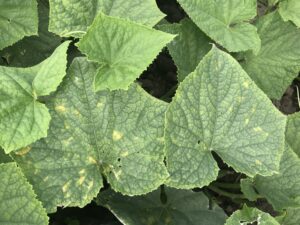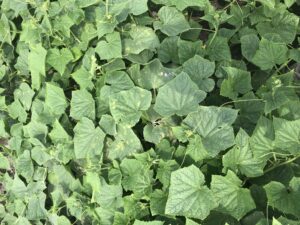Downy Mildew Confirmed on Cucumbers in Eastern North Carolina
go.ncsu.edu/readext?1077399
en Español / em Português
El inglés es el idioma de control de esta página. En la medida en que haya algún conflicto entre la traducción al inglés y la traducción, el inglés prevalece.
Al hacer clic en el enlace de traducción se activa un servicio de traducción gratuito para convertir la página al español. Al igual que con cualquier traducción por Internet, la conversión no es sensible al contexto y puede que no traduzca el texto en su significado original. NC State Extension no garantiza la exactitud del texto traducido. Por favor, tenga en cuenta que algunas aplicaciones y/o servicios pueden no funcionar como se espera cuando se traducen.
Português
Inglês é o idioma de controle desta página. Na medida que haja algum conflito entre o texto original em Inglês e a tradução, o Inglês prevalece.
Ao clicar no link de tradução, um serviço gratuito de tradução será ativado para converter a página para o Português. Como em qualquer tradução pela internet, a conversão não é sensivel ao contexto e pode não ocorrer a tradução para o significado orginal. O serviço de Extensão da Carolina do Norte (NC State Extension) não garante a exatidão do texto traduzido. Por favor, observe que algumas funções ou serviços podem não funcionar como esperado após a tradução.
English
English is the controlling language of this page. To the extent there is any conflict between the English text and the translation, English controls.
Clicking on the translation link activates a free translation service to convert the page to Spanish. As with any Internet translation, the conversion is not context-sensitive and may not translate the text to its original meaning. NC State Extension does not guarantee the accuracy of the translated text. Please note that some applications and/or services may not function as expected when translated.
Collapse ▲Downy mildew, caused by the oomycete Pseudoperonospora cubensis, has been identified on cucumber crops in Eastern North Carolina as of June 10, 2025. Disease symptoms were observed in commercial fields, with a confirmed disease severity of approximately 10% (Figure 1).
July 7, 2025 update: Downy mildew is suspected on cucumber in Rowan County, but has not yet been confirmed. Regardless, growers in the central part of the state should be applying fungicides as directed below.
Initial symptoms included yellow, angular lesions on the upper surface of the leaves, which are characteristic of the disease (Figure 2). A gray to dark purple fuzzy growth was evident underneath the leaves, corresponding to the sporulation of the pathogen. Microscopic diagnostics with a hand lens confirmed the presence of P. cubensis sporangia, verifying active infection.

Figure 2: Chlorotic, angular lesions on the upper side of the leaf (Photo credit: Erin Eure, NC State Extension)
In North Carolina, the pathogen occurs in two genetically distinct groups, or clades. Clade 2 affects cucumbers and cantaloupes, while Clade 1 is associated with watermelon, squash, and pumpkins. The current outbreak is attributed to Clade 2, which tends to arrive in the region early in the season via wind borne spores from the south. This puts cucumbers and cantaloupes at high risk.
To limit crop damage, it is critical to begin or adjust fungicide applications immediately. Choose products proven effective against Clade 2 downy mildew and rotate among different fungicide classes to reduce resistance development. North Carolina’s annual fungicide trials continue to demonstrate variable effectiveness depending on clade and host, so consult the latest cucurbit downy mildew fact sheet for updated chemical recommendations.
Downy mildew pathogens can adapt quickly to fungicides, making resistance management a top priority. Avoid repeated use of single-mode-of-action fungicides. Integrating protectants with systemic chemistries provides the best chance for disease suppression.
If you suspect downy mildew, contact your local Extension Agent promptly. The NC State Plant Disease and Insect Clinic accepts both digital photo submissions and physical plant samples for diagnosis. Confirmed cases can also be reported anonymously to the Cucurbit Downy Mildew IPMpipe website, a critical tool for tracking the disease’s spread across the U.S.
Growers and homeowners alike should scout cucurbit leaves frequently and look for early signs of downy mildew. Early detection and rapid response are essential to minimize losses.
Sign up for downy mildew alerts via the CDM IPM PIPE system to receive notifications through text, email, or phone when new outbreaks are detected near you. For real-time updates and other disease alerts, follow our team.



